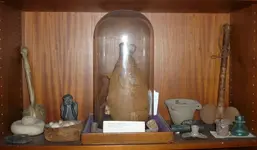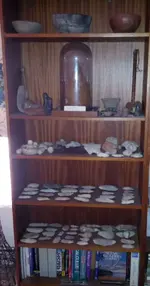Thought some might enjoy seeing the center piece of my collection, others may have see it years ago when I posted it.
The water bottle was found in New Mexico along with the iron axe with handle and a bowl. I have had it for over 25 years, I bought it from a good friend who had a business dealing in antique newspapers who acquired it in a trade, I also use to deal in antique newspapers, he was not a collector but knew I was and knew I would be interested. I paid $700 for all 3 pieces and was offered a $1000 for the bottle alone by another customer who came in before I left, he was the VP of the St Louis Archaeology Society and really wanted the bottle. The last offer I turned down was $5,000.
The Univ of new Mexico who examined it stated it was over 400 years old at that time using the leather to carbon date it. It is made from the bladder of a grizzly bear, that was filled with water, then covered in clay and allowed to dry. It has leather carrying straps on it that holds fetishes and bird whistle made from bone, the top cap on bottle is from the tip of a buffalo horn,
The iron axe on the right came with the deal as did the bowl on the left holding game marbles in front of the clay figure. The axe has the original handle, wrapped in leather and has an iron bit. I turned down a $1500 dollar offer for axe over 15 years ago.
The university said the iron had to have been from when the Conquistadors came north from Mexico into New Mexico as that was the only way they could have gotten iron then. Only reason the pieces are so well preserved is because New Mexico is so dry and they pieces were protected from elements.
There are stories on each of the other pieces on the shelf, this is one of 2 book cases, also have curio cabinet full of artifacts and a glass display case with electric rotating shelves.


The water bottle was found in New Mexico along with the iron axe with handle and a bowl. I have had it for over 25 years, I bought it from a good friend who had a business dealing in antique newspapers who acquired it in a trade, I also use to deal in antique newspapers, he was not a collector but knew I was and knew I would be interested. I paid $700 for all 3 pieces and was offered a $1000 for the bottle alone by another customer who came in before I left, he was the VP of the St Louis Archaeology Society and really wanted the bottle. The last offer I turned down was $5,000.
The Univ of new Mexico who examined it stated it was over 400 years old at that time using the leather to carbon date it. It is made from the bladder of a grizzly bear, that was filled with water, then covered in clay and allowed to dry. It has leather carrying straps on it that holds fetishes and bird whistle made from bone, the top cap on bottle is from the tip of a buffalo horn,
The iron axe on the right came with the deal as did the bowl on the left holding game marbles in front of the clay figure. The axe has the original handle, wrapped in leather and has an iron bit. I turned down a $1500 dollar offer for axe over 15 years ago.
The university said the iron had to have been from when the Conquistadors came north from Mexico into New Mexico as that was the only way they could have gotten iron then. Only reason the pieces are so well preserved is because New Mexico is so dry and they pieces were protected from elements.
There are stories on each of the other pieces on the shelf, this is one of 2 book cases, also have curio cabinet full of artifacts and a glass display case with electric rotating shelves.


Last edited:
Upvote
0




